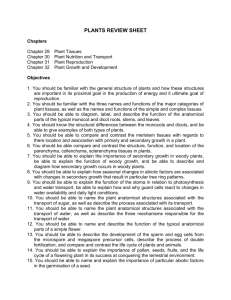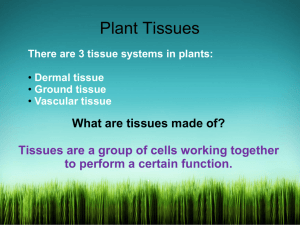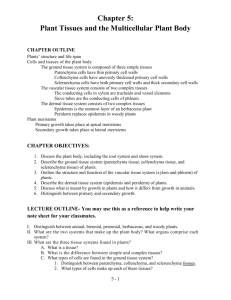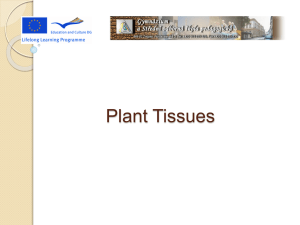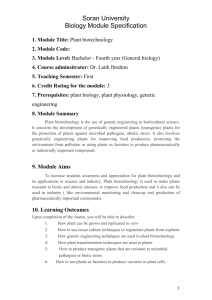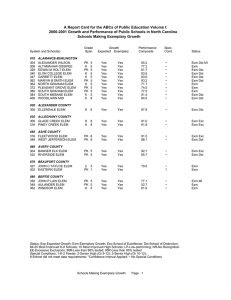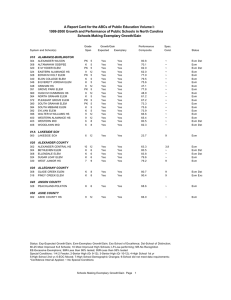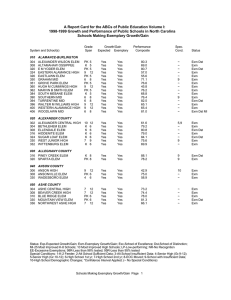1. Module Title - Soran University
advertisement
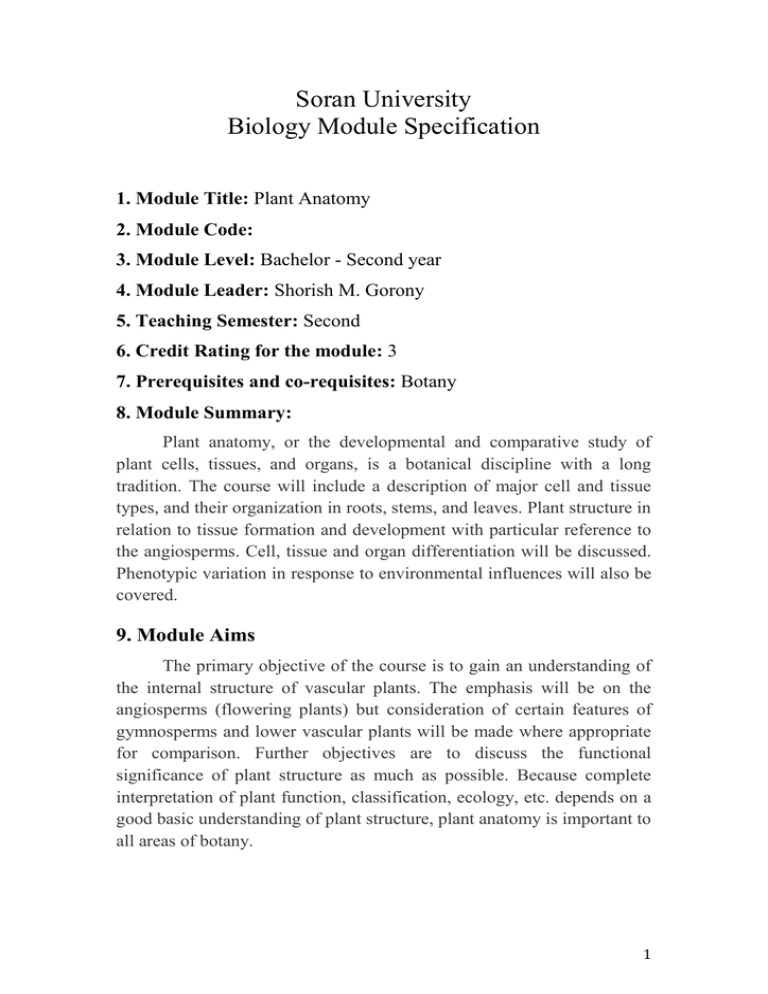
Soran University Biology Module Specification 1. Module Title: Plant Anatomy 2. Module Code: 3. Module Level: Bachelor - Second year 4. Module Leader: Shorish M. Gorony 5. Teaching Semester: Second 6. Credit Rating for the module: 3 7. Prerequisites and co-requisites: Botany 8. Module Summary: Plant anatomy, or the developmental and comparative study of plant cells, tissues, and organs, is a botanical discipline with a long tradition. The course will include a description of major cell and tissue types, and their organization in roots, stems, and leaves. Plant structure in relation to tissue formation and development with particular reference to the angiosperms. Cell, tissue and organ differentiation will be discussed. Phenotypic variation in response to environmental influences will also be covered. 9. Module Aims The primary objective of the course is to gain an understanding of the internal structure of vascular plants. The emphasis will be on the angiosperms (flowering plants) but consideration of certain features of gymnosperms and lower vascular plants will be made where appropriate for comparison. Further objectives are to discuss the functional significance of plant structure as much as possible. Because complete interpretation of plant function, classification, ecology, etc. depends on a good basic understanding of plant structure, plant anatomy is important to all areas of botany. 1 10. Learning Outcomes Upon completion of the course, you will be able to: 1. Understand the hierarchy of plant structure by learning the basic features of plant cells, tissues, and organs. 2. Differentiate between the basic systematic groups of vascular plants: ferns and fern allies, gymnosperms, and angiosperms. 3. Relate function of an organ to structure 4. To instill in students an appreciation for the complexity of tissue organization that exists within plant bodies that allow plants to develop and live as integrated organisms in diverse environments. 5. Describe organization of tissues and cells in each plant organ and how it responds to changes in the environment. 6. Interpret the basic pattern of plant growth from different kinds of meristems and understand the relationships between primary growth and secondary growth. 7. Understand how plant morphology relates to plant reproduction. 8. Plant morphological and anatomical defense mechanisms. 11. Syllabus Weak1 Weak2 Weak3 Weak4 Weak5 Weak6 Weak7 Weak8 Weak9 Weak10 Weak11 Weak12 Introduction The cell wall and Pits Living and Non-Living components of plant cell Plant tissues (Meristimatic tissue) 1st Midterm EXM Permanent tissue Tissue: Parenchyma and Collenchyma Tissue: Sclerenchyma Tissue: Xylem and Phloem 2nd Midterm EXM Root (Secondary growth of root) Stem (Secondary growth of stem) Leaf (Secondary growth of Leaf) Secretory Cells and Tissues 3rd Midterm EXM 12. Assessment Strategy There are two parts to this course, the lecture and the laboratory. The lecture will provide an opportunity to discuss conceptual information in the text, and current topics in the subject. The laboratory will provide hands-on opportunities in structured labs and in independent 2 investigations. Both will count significantly to student’s final grade. 13. Summary description of assessment Assessment Type Theory EXM 3 Midterm EXM Final EXM Practical EXM 2 Midterm EXM Description of Item -Exam questions will be multiple choice, matching, and short essay. Some questions will ask you to complete a diagram. Some short essay questions may be synthetic, meaning that you will be presented with a situation that we have not discussed in class and must reason to a conclusion using what you have learned. Material for exams will be taken from lecture, and sometimes outside reading assignments. Exam questions will be short answer questions such as; identification of slides, definition of some topics (materials)…..etc. Final EXM GWK+ PRS Quizzes + Tutorial + Lab activity % Weighting 65 % Grading Tariff Excellent: ≥ 90 3 Onehour EXM 25 % Very Good:80-89% 40 % 2 Hours Good: 70-79 % Medium: 60-69 % 30 % Fair: 50-59 % 10 % 1 Hour 20 % 1 Hour 5% 14. Learning Session Structure: 1 x 2 h lectures, 1 x 2 h practical sessions, and 1x 1h tutorial per week in 12 weeks. 15. Scheme of Work: Week Delivery Method Content 1 Lecture Introduction to the Class -Course book description. -Plant cell Practical No Lab Learning Materials ppt Learning Outcomes - Botany Review 3 2 Lecture -The cell wall -Pits 3 Practical Lecture -Cell wall -Living and Non-Living components of plant cell 4 Practical Lecture ppt -Anatomical description of cell wall and Pits. -Structure and composition of cell wall. -Function of cell wall and its role in plant morphology. ppt -Anatomy of each particle of cell component. -Function of each cell organelle -Working mechanism of cell organelle. ppt -Characteristics of Meristematic cells. -Type of Meristimatic cell division. - Classification of meristems. ppt -Characteristics of Permanent tissues. -Classification of Permanent tissues. -Understanding dermal tissues and epidermis. ppt -Characteristics of Parenchyma and Collenchyma tissue. -Origin of Parenchyma and Collenchyma tissue. -Functions of Parenchyma and Collenchyma tissue. -Types of Parenchyma and Collenchyma tissue. -Characteristics of Sclerenchyma tissue. -Origin of Sclerenchyma and Fibers tissue. -Functions of Sclerenchyma tissue. -Types of Sclerenchyma and Fibers tissue. -Pit and Primary pits fields -Plant tissues -Meristematic tissues -Root and Shoot apex 5 Practical Lecture 1stMidterm EXM -Living components of plant cell -Permanent tissue -Structural development and differentiation. -Epidermis Practical -Non –Living Components of plant cell 6 Lecture -Tissue: Parenchyma -Tissue: Collenchyma tissue -Permanent tissue 7 Practical 1st EXM Lecture - Tissue: Sclerenchyma - Fibers ppt - Sclereids 8 Practical Lecture Practical -Parenchyma and Collenchyma tissues. -Tissue: Xylem -Tissue: Phloem - Sclerenchyma tissue. ppt -Anatomical structure of Xylem and Phloem tissue. -Definition of Xylem and Phloem tissue. - Shapes of Xylem and Phloem tissue. 4 9 Lecture 2nd Midterm EXM Practical - Root ppt - Internal structure of root. - Root system types. - Root function. - Primary and secondary growth of root. ppt - Vascular bundle types - Primary and secondary growth of stem. -Leaf traces and leaf gaps (nodal anatomy). -The stele concept. ppt - Leaf arrangement (Phyllotaxy). - Leaf form. - Leaf anatomy. - Leaf development. - Leaf abscission. - Connections between structure and function of leaf. ppt - Origin of Secretory Cells and Tissues. - Classification of Secretory Cells and Tissues. - Water Stomata (Hydathodes). - External or Dermal glands. - Internal or Globular glands. - Tubular Secretory canals. Secondary growth of root (the structure and growth of root). 10 Lecture - Vascular system (Xylem and Phloem). - Stem Secondary growth of stem (the structure and growth of stem) 11 Practical Lecture -Root anatomy - Leaf Overall leaf morphology Practical 2nd EXM 12 Lecture 3rd Midterm EXM Practical -Stem anatomy - Secretory Cells and Tissues -Lesf anatomy 16. Bibliography 1. D.F. Culter, C.E.J. Botha, D.W. Stevenson 2007. PLANT ANATOMY (An Applied Approach). First edition. 2. E. R. Franklin 2006. ESAU’S PLANT ANATOMY (Meristems, Cells, and Tissues of the Plant Body). Third edition. 3. W. Ch. Stevens. PLANT ANATOMY. Fourth edition. 4. William C. Dickison, 2000. Integrative plant anatomy. 17. Authored by Shorish M. Gorony 18. Validated and Verified by 5
